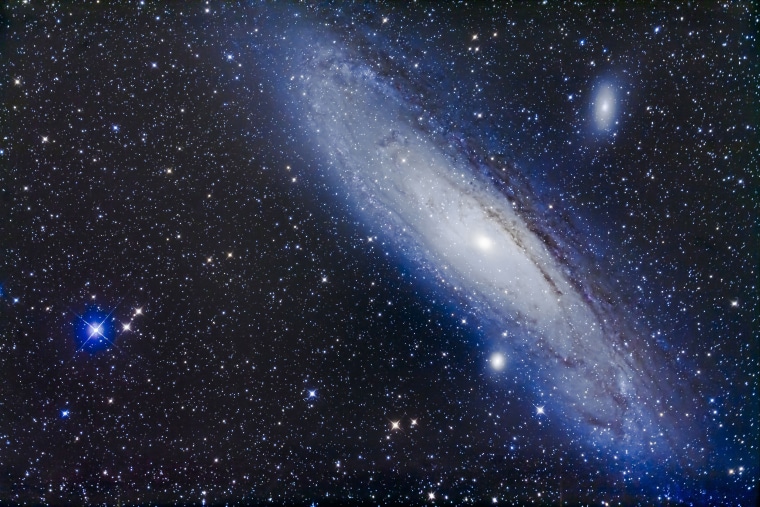A controversial 20-minute interaction with a humpback whale might help scientists communicate with extraterrestrials and nonhuman Earthlings alike

For some scientists who are eager to talk with aliens, the best avenue isn’t any telescope pointed to the heavens but rather a boat slipping through the glassy waters of Alaska’s Frederick Sound. This area is a seasonal hotspot for humpback whales, whose eerie and enchanting submarine songs may serve as proxies for any alien transmissions that practitioners of SETI (the search for extraterrestrial intelligence) may eventually receive. In a recent paper published in the journal Aquatic Biology, a group of researchers reported a humpback encounter at Frederick Sound that they say is a compelling case of interspecies communication, with lessons for parsing future messages from the stars. But critics aren’t so sure.
The debate highlights a lingering tension between SETI’s lofty aspirations and the down-to-earth limits of our knowledge: How can we hope to find intelligent life out there—let alone chat with it—when we struggle to perceive and communicate with intelligent nonhuman creatures right here on our home world?
Laurance Doyle, an astronomer at the SETI Institute and a co-author of the study, says such questions are exactly why he and his colleagues were listening to whales in the first place. “We’re trying to get on the outside of nonhuman intelligence,” he says. “We’re trying to understand it so that when we get an extraterrestrial signal, we’ll know what to do.”
The encounter occurred on August 19, 2021, around the 18-meter research vessel Glacier Seal. It began when Doyle and others onboard spotted a nearby humpback, which was later identified as a female nicknamed “Twain.” Attempting to catch Twain’s attention, the researchers used an underwater speaker to play a series of humpback vocalizations they had recorded in Frederick Sound in the prior afternoon. After three broadcasts reverberated through the depths, the creature slowly approached the boat. With every vocalization that echoed from the speaker, Twain responded in kind—often with a nearly identical call. For 20 minutes, the whale circled the Glacier Seal, engaging in the call-and-response exchange and making a total of 36 calls before swimming away—and leaving Doyle and his shipmates with the impression that they had just witnessed a potential milestone in human-cetacean communications.
One World, Many Minds
Notions of similar milestones trace back to SETI’s very roots. At a historic meeting in 1961, a select group of scientists codified key tenets of the then nascent field. One of the invited attendees was John Lilly, a neuroscientist who claimed to have talked with captive bottlenose dolphins at a specialized research center that he’d established in the U.S. Virgin Islands. Impressed by Lilly’s research and his contributions to the meeting, the other participants ultimately called themselves the Order of the Dolphin. Although Lilly’s controversial practices eventually pushed him far beyond the bounds of orthodox science, reputable researchers still acknowledge the importance of his early results, which laid the groundwork for more rigorous subsequent attempts at cetacean communication
But then and now some fundamental stumbling blocks exist: How exactly should we quantify concepts like “communication” and “intelligence” across species? And can we do so in a way that minimizes our decidedly anthropocentric biases? For Doyle and the study’s lead author, Brenda McCowan, an animal behaviorist at the University of California, Davis, one possible answer lies within the presumptive universal language of mathematics, filtered through analytic techniques from a subdiscipline known as information theory. “We have millions of communication systems on Earth—plants, animals, and so on,” Doyle says. “But how communicative are they? The next question requires information theory.”
Birthed in the late 1940s from the work of mathematician and computer scientist Claude Shannon, information theory underpins all modern digital communications. For instance, its methods for quantifying complexity and syntax are crucial for finding signals obscured by noise, as well as for making—and breaking—cryptographic codes. Presumably, then, information theory should be useful for deciphering and cataloging the information that is carried within not only whale songs and dolphin whistles but the signaling behaviors of many other organisms as well. This could, the thinking goes, eventually lead to transformative results—such as a hierarchical library of sorts, in which the diverse communication systems of Earth’s biosphere are classified based on their complexity, whether found in humans, whales, plants, microbes or any other living thing. That, in turn, could help form a framework for understanding different forms of intelligence, both on and beyond our isolated planet.
This objective and similarly audacious goals remain very much a work in progress. For now, researchers such as Doyle and McCowan are focused on simpler applications. In their encounter with Twain, they looked for a communication pattern called latency matching, deliberately shifting the timing between their broadcasts in hopes that the whale would match the temporal delays. That the whale did exactly this, they say, was in large part what made the interaction so compelling and noteworthy. Twain’s latency matching, they speculate, may have been an attempt to engage in a discussion.
A Promising First Step
Yet many researchers—and even the study’s authors themselves—are hesitant to say the exchange can be considered anything close to a “conversation.”
Peter Tyack, a marine biologist at the University of St. Andrews in Scotland, who specializes in cetacean research and was not part of the study, is one such skeptic. Based on other latency-matching work dating back to the 1980s, he says, scientists have long known that whales—and many animals, for that matter—adjust the timing of their calls to avoid overlaps with another caller. So mere expediency, rather than curiosity, can adequately explain Twain’s behavior. “I do not think that similar results from the authors’ playbacks of humpback sound supports the claim that the whale was intentionally trying to create a cross-species interaction,” he says.
Such criticisms—which assume that the whale didn’t realize she was communicating with humans or at least couldn’t discern that the sound wasn’t emanating directly from another nearby whale—strike the study authors as special pleading. It’s far more likely, they argue, that Twain knew the boat—if not its human passengers—was the proximate source of what she heard. “I think initially she could’ve thought it was her own sound or another whale, but she had these periods of time where she could have gone underwater to inspect us,” says Fred Sharpe, a co-author of the study and a marine biologist at the Alaska Whale Foundation. Twain, he notes, stayed within 100 meters of the boat for the duration of the encounter, presumably reducing the chance of mistaken identity. And when the team ceased its broadcast because of protocol-mandated limits on their scientific study, he adds, Twain lingered for a time and kept calling—as if awaiting another response.
Outside of the debate about latency matching, other researchers who were not involved with the study are quick to suggest that its appeal may arise more from the charisma of its cetacean subjects rather than the notability of its science. After all, other animals—Alex the parrot, Koko the gorilla and many less famous creatures—have shown evidence of symbolic communication and abstract thought in various investigations across the decades.
“This type of playback has been done many times with birds and frogs and in a much more rigorous context,” notes behavioral ecologist and animal acoustic communication specialist Mickey Pardo of Cornell University, who wasn’t involved in the new study. “A lot of other animals are highly intelligent but don’t get as much credit as whales, and it hasn’t been considered a ‘conversation’ in the past when we look at studies with other animals.”
Pardo suggests that the team’s encounter with Twain is best seen as a promising first step toward more ambitious future studies—ones in which researchers could attempt more interactive playback, test more honed hypotheses and incorporate participation from a larger number of whales.
“This is very preliminary, and we were very limited in the ways in which we could modify the signal,” McCowan acknowledges. “It was such a rare and opportunistic circumstance with a being that is incredibly difficult to study, that we thought it should be shared. The idea is to go back and replicate something like this,” she says.
Regardless of any extraterrestrial implications, there is hope that the study will contribute to conservation initiatives and the ways in which we engage with animals. Doyle notes that while the “head” of the research is its connection with SETI, its “heart” lies in reshaping our relationship with life here on Earth, to identify and—if possible—reduce our anthropocentric prejudices. “Maybe we need to think about animals differently on this planet. They themselves can be quite alien to us in many ways,” McCowan says. “There’s an analogy to be made here of equity, inclusion and diversity of cultures both in our own species and across species—which is something we need to preach better to.”
Earth’s ocean and the whales that send their songs reverberating through its abyss offer analogies, too—to the vast depths of outer space and the possibilities of beings somehow sending messages across light-years to commune with one another. In both cases, perhaps our struggle to find anyone to talk to is mostly a function of our ignorance, our failure to look and listen in the proper ways.
“If we’re not picking up on animal intelligence, [their] overtures, or even deciphering their communication systems, no wonder we gaze out on a silent universe!” Sharpe says. “We could be awash with alien signals, and we just don’t have the perceptual bandwidth yet or the ability to recognize and interpret them. A humpback whale illustrates that really well.”






